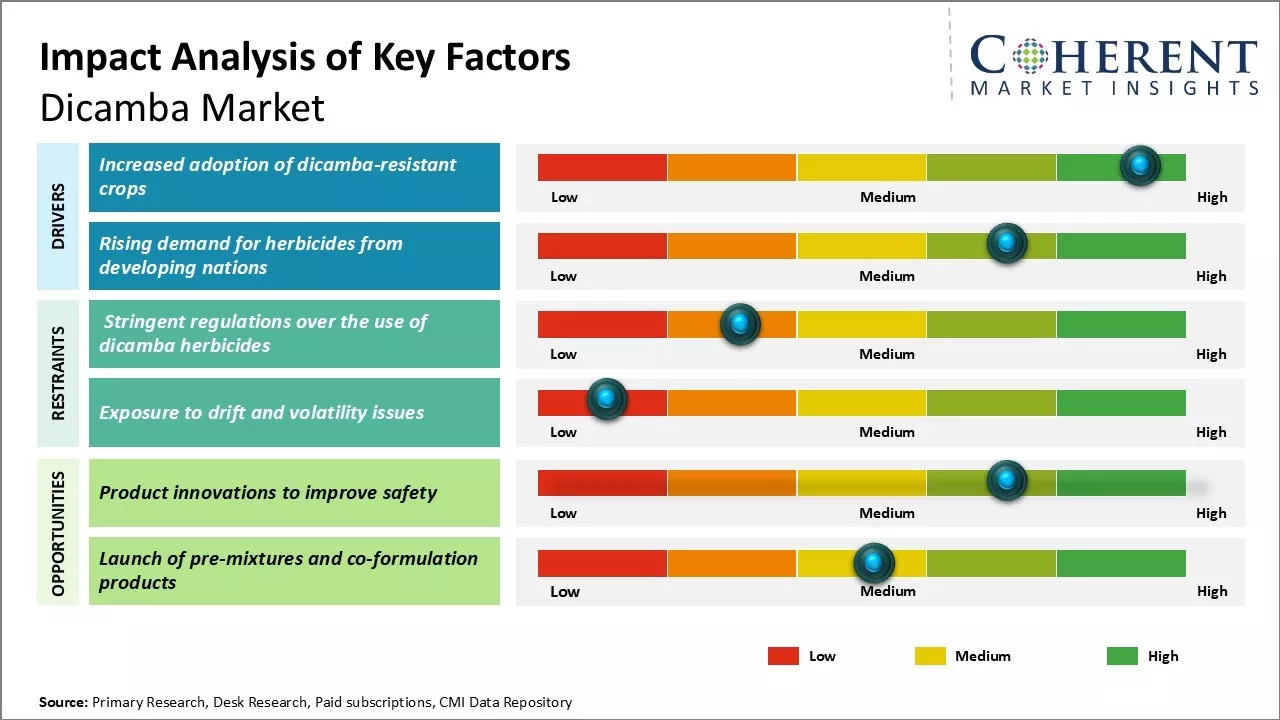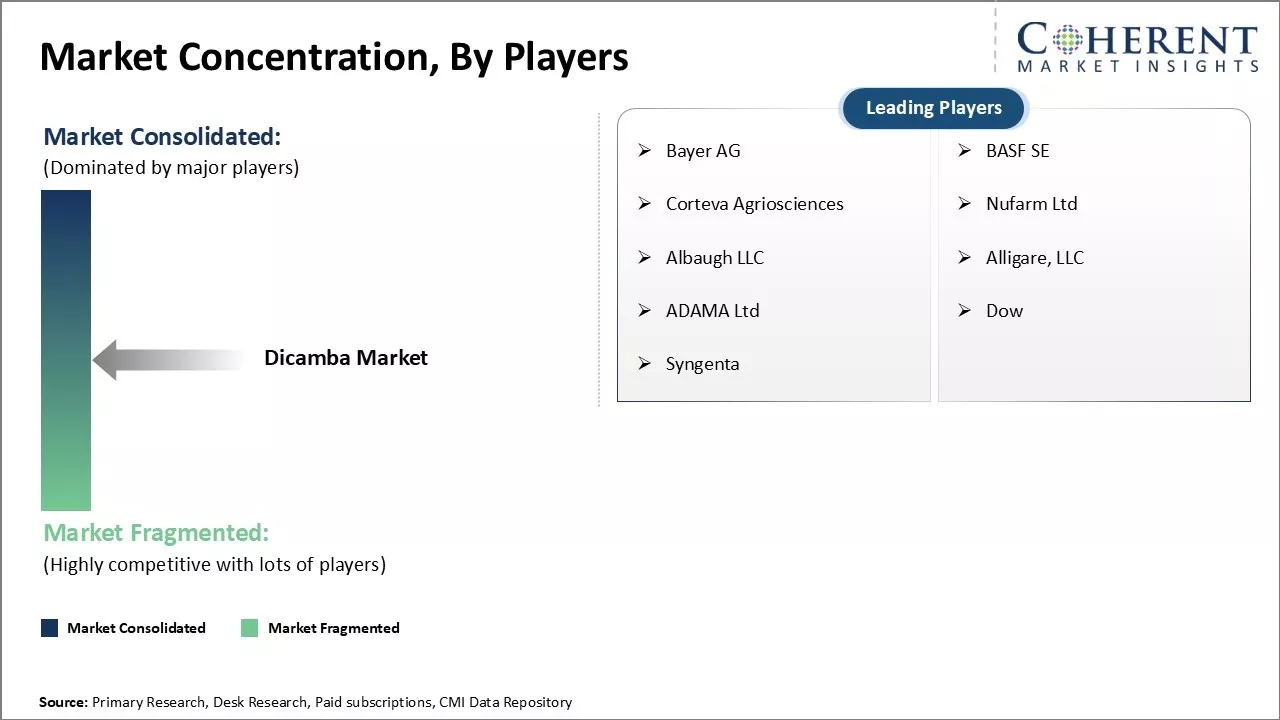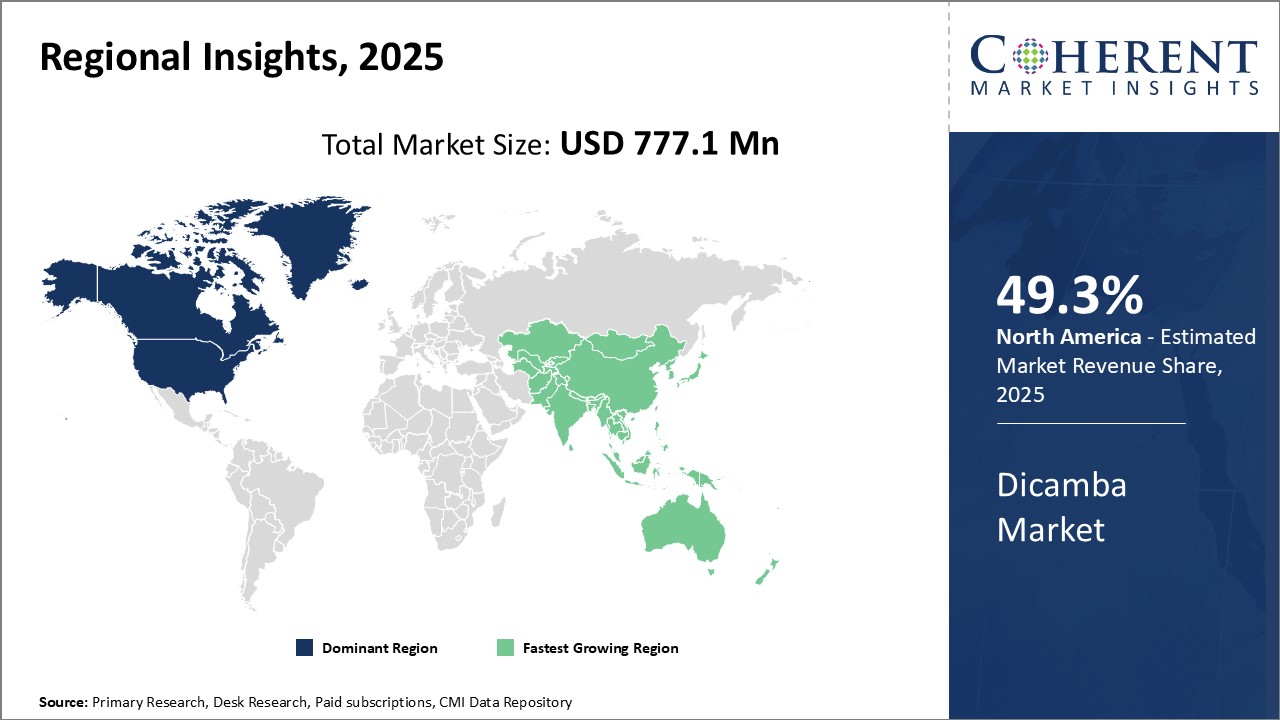The global dicamba market is estimated to be valued at USD 777.1 Mn in 2025 and is expected to reach USD 1,324.0 Mn by 2032, exhibiting a compound annual growth rate (CAGR) of 7.9% from 2025 to 2032.

To learn more about this report, Download Free Sample
Dicamba is perhaps the most popular herbicide globally used in agriculture, mainly attributed to its efficacy in managing broadleaf weeds in major crop complexes. The key driver for the dicamba market is its post-emergent use as a herbicide-tolerant genetically modified (GM) crop like soybean, cotton, and corn, where efficient weed control is crucial for achieving high yields and reducing competition between crops.
For instance, in June 2024, BASF submitted a revised label proposal for its dicamba-based herbicide, Engenia, to the U.S. Environmental Protection Agency (EPA). This proposal aimed to allow over-the-top (OTT) applications on dicamba-tolerant soybeans up to the V2 growth stage or until June 12, whichever comes first, and on cotton until July 30.
|
Current Event |
Description and its impact |
|
Increased Adoption of Herbicide-Tolerant Crops |
|
|
Regulatory Advancements Favoring Low-Volatility Formulations |
|
|
Rising Weed Resistance to Traditional Herbicides |
|
Uncover macros and micros vetted on 75+ parameters: Get instant access to report
More perhaps than any of dicamba research focus areas, however, has been the development of low-volatility versions of the product. Typical formulations of dicamba have been implicated in off-site damage caused by vapour drift and have initiated regulation and restrictions on use in a few locations.
In addition to herbicide advancements, there is a big push to produce genetically modified crops that are resistant to dicamba. This is particularly relevant for crops such as soybeans, cotton, and corn, which are very prone to infestations of weeds.
another hopeful segment of the pipeline is the creation of combination herbicide products that blend dicamba with other herbicides such as glyphosate or glufosinate. These combinations are aimed at fighting herbicide-resistant weeds, which are increasingly becoming a problem in farming.
With the expanding dicamba market comes an important role for the regulatory environment to shape the industry's future. With stricter regulations on the use of Speciality pesticides across much of the globe, companies must navigate complicated approval processes to bring new formulations to market.
One of the top areas of patent activity is in low-volatility dicamba product technology. Traditional dicamba products have been linked to crop damage through vapor drift, especially in warm weather. Later patents deal with stabilizers like vapour grip polymers that do not volatilize easily.
The second most popular area of interest in the patent world is the creation of genetically modified (GM) crop varieties that are tolerant of dicamba. Bayer and Corteva, among other firms, have patented soybeans, cotton, and other dicamba-tolerant crops.
Patents on mix herbicides including dicamba with other active ingredients like glyphosate or glufosinate are on the rise. They are attempting to have improved weed management, particularly against resistant weeds.
The dicamba-related crop damage reimbursement is multifaceted and region-specific, as dicamba is an herbicide commonly applied to control weeds in agricultural crops. Dicamba drift in the United States has become a major issue, and thus reimbursement for off-target movement of herbicides is problematic.
Dicamba drift due to the herbicide's volatility is not insured under federal crop insurance policies. The Risk Management Agency (RMA) has clearly excluded chemical damage, such as herbicide drift, from federal crop insurance. Growers who have been subjected to dicamba drift usually cannot claim under their crop insurance for herbicide-caused yield loss.
certain states have launched their compensation schemes or mitigation efforts to compensate for crop damage caused by dicamba. These state-initiated schemes could offer relief on a partial basis or facilitate mediation between the parties.
While dicamba-caused crop injury is not covered in federal programs, liability insurance can provide some form of recompense. Farmers and applicators can purchase liability insurance policies that may provide coverage for off-target herbicide movement-related injury.
Dicamba is preferred by farmers and agronomists because of its wide-spectrum weed control, especially against perennial and troublesome broadleaf weeds like marestail, pigweeds, and lamb's quarters. Its long history of previous use in crops such as soybeans, cotton, and corn has established it as a trusted alternative for combating resistant populations of weeds.
Safety considerations are a significant element in the prescriber's decision. Volatility of dicamba, which leads to off-target drifting, has generated more publicity and regulatory scrutiny in recent years. Consequently, prescribers have been even more careful writing for dicamba products, especially in windy conditions or near sensitive crops.
Regulations also affect prescribers' choices. With ongoing concerns over dicamba's impact on the environment and crops as a result of off-target drift, regulatory agencies have set more restricted use regulations and application windows.
Price continues to be a key determining factor for prescribers. Dicamba tends to be viewed as a low-cost option, particularly when it is compared with other herbicides that might need to be applied several times in order to obtain similar effects. Price sensitivity could shift, however, as new formulations become available with increased safety profiles and effectiveness.

To learn more about this report, Download Free Sample
Over the past few years, dicamba-resistant crop production has increased immensely, especially in high-input cropping systems. Dicamba, a widely used herbicide, is particularly efficient in weed control after emergence, enabling farmers to manage tough, resistant weed populations. This accelerated progress is mostly attributed to the increasing pressure of weed resistance to herbicides and the demand for effective crop protection.
In March 2025, the U.S. Environmental Protection Agency (EPA) maintained the ban on over-the-top (OTT) applications of dicamba herbicides for dicamba-tolerant soybeans and cotton.This decision stems from a 2024 federal court ruling that vacated the registrations of key dicamba products—XtendiMax, Engenia, and Tavium—due to concerns over off-target drift and environmental impact.
A significant growth potential in the global dicamba market is in the ongoing development of safer herbicide formulations. Traditional dicamba products have been faulted due to their high volatility, leading to the herbicide blowing away from intended fields and damaging nearby crops. Due to these concerns, developers are focusing on making new, low-volatility varieties.
As per a 2021 report by the U.S. Department of Agriculture, these new formulations showed a maximum of 97% less volatility than previous versions, pointing towards their efficiency in enhancing application safety. These innovations not only lower environmental and crop risk but also increase regulatory acceptance and consumer confidence.
The liquid formulation of dicamba is expected to dominate the market by form with the largest market share in 2025. This is because liquid formulations are easy to apply. Farmers use liquid dicamba because it is compatible with conventional spraying equipment, making it possible to cover fields quickly and efficiently.
Due to the increasing requirement for selective control of weeds post-emergence of crops. Dicamba is especially desirable because of its effectiveness against subsequent-emerging broadleaf weeds, which could be damaging to late-season crops.
The cereals and grains segment is expected to represent 26.9% of the global market in 2025, reflecting the extensive use of dicamba in major crops like wheat and maize.

To learn more about this report, Download Free Sample
North America is also estimated to lead the world in dicamba market with the highest share in 2025. The leading position is mainly fuelled by the extensive use of crop varieties that are resistant to dicamba and continuous application of post-emergent herbicides over extensive fields in the United States and Canada.
The Asia Pacific region is anticipated to be the fastest-growing market for dicamba from 2025 to 2032. This growth is stimulated by the rapid rate of expansion in agricultural activities in developing nations such as India, China, Indonesia, and Vietnam. The governments in these nations are embarking on farmer-specific programs, subsidies, and training to increase the yield of crops and improve weed management practices.
The United States controls the global dicamba market through widespread application of dicamba-resistant crops and innovative farm methods. With nearly all soybean and cotton plantings in major U.S. agricultural states utilizing dicamba-tolerant varieties, dicamba herbicide demand remains on the rise.
Brazil becomes a market leader in the global dicamba market due to its growing production of soybean and maize, which are among the most valued crops treated with dicamba-formulated herbicides. The tropical climate of the country favours infestation by invasive broadleaf weeds, which enhances post-emergent herbicide product demand.
| Report Coverage | Details | ||
|---|---|---|---|
| Base Year: | 2024 | Market Size in 2025: | USD 777.1 Mn |
| Historical Data for: | 2020 To 2024 | Forecast Period: | 2025 To 2032 |
| Forecast Period 2025 to 2032 CAGR: | 7.9% | 2032 Value Projection: | USD 1,324.0 Mn |
| Geographies covered: |
|
||
| Segments covered: |
|
||
| Companies covered: |
Bayer AG, BASF SE, Corteva Agriosciences, Nufarm Ltd, Albaugh LLC, Alligare, LLC, ADAMA Ltd, Dow, and Syngenta |
||
| Growth Drivers: |
|
||
| Restraints & Challenges: |
|
||
Uncover macros and micros vetted on 75+ parameters: Get instant access to report
Share
Share
About Author
Vidyesh Swar is a seasoned Consultant with a diverse background in market research and business consulting. With over 6 years of experience, Vidyesh has established a strong reputation for his proficiency in market estimations, supplier landscape analysis, and market share assessments for tailored research solution. Using his deep industry knowledge and analytical skills, he provides valuable insights and strategic recommendations, enabling clients to make informed decisions and navigate complex business landscapes.
Missing comfort of reading report in your local language? Find your preferred language :
Transform your Strategy with Exclusive Trending Reports :
Frequently Asked Questions
Joining thousands of companies around the world committed to making the Excellent Business Solutions.
View All Our Clients